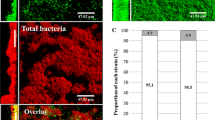Abstract
A cultivated form of bacteria (strain 2202) was isolated from the hemal fluid of the bivalve mollusk Modiolus kurilensis. Based on the set of data collected by genetic and physiological/biochemical analyses, the strain was identified as the species Pseudoalteromonas piscicida. Strain 2202 exhibits antimicrobial activity against Staphylococcus aureus, Candida albicans, and Bacillus subtilis but not against Escherichia coli and Pseudomonas aeruginosa. These activities characterize the behavior of strain 2202 as predator-like and classify it as a facultative predator. Being part of the normal microflora in the hemolymph of M. kurilensis, when external conditions change, strain 2202 shows features of opportunistic microflora. The strain 2202 exhibits selective toxicity towards larvae of various invertebrates: it impairs the early development of Mytilus edulis, but not of Strongylocentrotus nudus. Thus, the selective manner in which P. piscicida strains interact with various species of microorganisms and eukaryotes should be taken into consideration when using their biotechnological potential as a probiotic in aquaculture, source of antimicrobial substances, and factors that prevent fouling.





Similar content being viewed by others
References
Austin B (1993) Environmental issues in the control of bacterial diseases of farmed fish. In: Pullin RSV, Rosenthal H, Maclean JL (ed) Environment and Aquaculture in Developing Countries ICLARM (International Center for Living Aquatic Resources Management) Conference Proceedings 31. ICLARM, Manila, Philippines (now, WorldFish Center, Penang, Malaysia) and Deutsche Gesellschaft für Technische Zusammenarbeit. Germany, Eschborn. pp 237–251.
Austin B, Austin DA (2007) Bacterial fish pathogens: disease of farmed and wild fish, 4th edn. Springer Science and Business Media, UK
Beleneva IA, Kukhlevsky AD, Kharchenko UV (2013) Antimicrobial activity of heterotrophic bacterial strains of marine origin. Jundishapur J Microbiol 6:166–175
Beleneva IA, Shamshurina EV, Eliseikina MG (2015) Assessment of the toxic effect exerted by fluorescent pseudomonads on embryos and larvae of the sea urchin Strongylocentrotus nudus. Ecotoxicol Environ Saf 115:263–271
Bowman JP (2007) Bioactive compound synthetic capacity and ecological significance of marine bacterial genus Pseudoalteromonas. Mar Drugs 5:220–241
Brenner DJ, Krieg NR, Staley JT, Garrity GM (2005) Bergey's Manual of Systematic Bacteriology, 2nd Edition, Vol. 2 (The Proteobacteria), part C (The Alpha-, Beta-, Delta-, and Epsilonproteobacteria). Springer, New York.
Carillo S, Pieretti G, Parrilli E, Tutino ML, Gemma S, Molteni M, Lanzetta R, Parrilli M, Corsaro MM (2011) Structural Investigation and Biological Activity of the Lipooligosaccharide from the Psychrophilic Bacterium Pseudoalteromonas haloplanktis TAB 23. Chem Eur J 17:7053–7060
Choudhury JD, Pramanik A, Webster NS, Llewellyn LE, Gachhui R, Mukherjee J (2015) The pathogen of the great barrier reef sponge Rhopaloeides odorabile is a new strain of Pseudoalteromonas agarivorans containing abundant and diverse virulence-related genes. Mar Biotechnol 17:463–478
Desriac F, Defer D, Bourgougnon N, Brillet B, Le Chevalier P, Fleury Y (2010) Bacteriocin as weapons in the marine animal-associated bacteria warfare: inventory and potential applications as an aquaculture probiotic. Mar Drugs 8:1153–1177
Desriac F, Le Chevalier P, Brillet B, Leguerinel I, Thuillier B, Paillard C, Fleury Y (2014) Exploring the hologenome concept in marine bivalvia: haemolymph microbiota as a pertinent source of probiotics for aquaculture. FEMS Microbiol Lett 350(1):107–116
Dobretsov S, Xiong H, Xu Y, Levin A, Qian P-Y (2007) Novel antifoulants: inhibition of larval attachment by proteases. Mar Biotechnol 9:388–397
Donovan CJ, Garduno RA, Kalmokoff M, Ku JC, Quilliam MA, Gill TA (2009) Pseudoalteromonas bacteria are capable of degrading paralytic shellfish toxins. Appl Environ Microbiol 75(21):6919–6923
Dyachuk V, Odintsova N (2009) Development of the larval muscle system in the mussel Mytilus trossulus (Mollusca, Bivalvia). Dev Growth Differ 51:69–79
Gauthier G, Gauthier M, Christen R (1995) Phylogenetic analysis of the genera Alteromonas, Shewanella, and Moritella using genes coding for small-subunit rRNA sequences and division of the genus Alteromonas into two genera, Alteromonas (Emended) and Pseudoalteromonas gen. nov., and proposal of twelve new species combinations. Int J Syst Bacteriol 45:755–761
Glöckner FO, Fuchs BM, Amann R (1999) Bacterioplankton compositions of lakes and oceans: a first comparison based on fluorescence in situ hybridization. Appl Environ Microbiol 65:3721–3726
Hamsah W, Alimuddin YM, Zairin MZ (2017) The nutritional value of Artemia sp. enriched with the probiotic Pseudoalteromonas piscicida and the prebiotic mannan-oligosaccharide. AACL Bioflux 10:8–17
Harjodh S, Manpreet K, Manoj J, Sunita M, Hemraj N, Anil K (2019) Antimicrobial properties of the novel bacterial isolate Paenibacilllus sp. SMB1 from a halo-alkaline lake in India. Sci Rep 9:11561. https://doi.org/10.1038/s41598-019-47879-x
Harvey E, Deering R, Rowley C, El Gamal A, Schorn M, Moore B, Whalen K (2016) A bacterial quorum-sensing precursor induces mortality in the marine Coccolithophore, Emiliania Huxleyi. Front Microbiol. https://doi.org/10.3389/fmicb.2016.00059
Holmström C, Kjelleberg S (1999) Marine Pseudoalteromonas species are associated with higher organisms and produce biologically active extra-cellular agents. FEMS Microbiol Ecol 30:285–293
Hugh R, Leifson E (1953) The taxonomic significance of fermentative versus oxidative metabolism of carbohydrates by various gram-negative bacteria. J Bacteriol 66:24–26
Ivanova EP, Gorshkova NM, Sawabe T, Hayashi K, Kalinovskaya NI, Lysenko AM, Zhukova NV, Nicolau DV, Kuznetsova TA, Mikhailov VV, Christen R (2002) Pseudomonas extremorientalis sp. nov., isolated from a drinking water reservoir. Int J Syst Evol Microbiol 52:2113–2120
Ivanova EP, Flavier S, Christen R (2004) Phylogenetic relationships among marine Alteromonas-like proteobacteria: emended description of the family Alteromonadaceae and proposal of Pseudoalteromonadaceae fam. nov., Colwelliaceae fam. nov., Shewanellaceae fam. nov., Moritellaceae fam. nov., Ferrimonadaceae fam. nov., Idiomarinaceae fam. nov. and Psychromonadaceae fam. nov. Int J Syst Evol Microbiol 54:1773–1788
Ivanova EP, Ng HJ, Webb HK (2014) The Family Pseudoalteromonadaceae. In: Rosenberg E, DeLong EF, Lory S, Stackebrandt E, Thompson F (eds) The Prokaryotes. Springer, Berlin, pp 575–582
Katoh K, Misawa K, Kuma K, Miyata T (2002) MAFFT: a novel method for rapid multiple sequence alignment based on fast Fourier transform. Nucleic Acids Res 2:3059–3066
Katoh K, Standley DM (2013) MAFFT multiple sequence alignment software version 7: improvements in performance and usability. Mol Biol Evol 30:772–780
Kumar S, Stecher G, Li M, Knyaz C, Tamura K (2018) MEGA X: molecular evolutionary genetics analysis across computing platforms. Mol Biol Evol 35:1547–1549
Lane DJ (1991) 16S/23S sequencing. In: Stackebrandt E, Goodfellow M (eds) Nucleic acid techniques in bacterial systematic. John Wiley & Sons, Chichester, pp 115–175
Martin MO (2002) Predatory prokaryotes: an emerging research opportunity. J Mol Microbiol Biotechnol 4:467–478
Moeller V (1955) Simplified tests for some amino acid decarboxylases and for the arginine dihydrolase system. Acta Pathol Microbiol Scand 36:158–172
Nelson EJ, Ghiorse WC (1999) Isolation and identification of Pseudoalteromonas piscicida strain Cura-d associated with diseased damselfish (Pomacentridae) eggs. J Fish Dis 22:253–260
Oelschlaeger TA (2010) Mechanisms of probiotic actions—a review. Int J Med Microbiol 300(1):57–62
Offret C, Desriac F, Le Chevalier P, Mounier J, Jégou C, Fleury Y (2016) Spotlight on antimicrobial metabolites from the marine bacteria Pseudoalteromonas: Chemodiversity and ecological significance. Mar Drugs 14:129
Offret C, Jegou C, Mounier J, Fleury Y, Le Chevalier P (2019) New insights into the haemo- and coelo-microbiota with antimicrobial activities from Echinodermata and Mollusca. J Appl Microbiol 126(4):1023–1031
Pagano G, Guida M, Trifuoggi M, Thomas P, Palumbo A, Romano G, Oral R (2017) Sea urchin bioassays in toxicity testing: I. inorganics, organics, complex mixtures and natural products. Expert Opin Environ Biol 6:1
Papaleo MC, Fondi M, Maida I, Perrin E, Lo Giudice A, Michaud L, Mangano S, Bartolucci G, Romoli R, Fani R (2012) Sponge-associated microbial Antarctic communities exhibiting antimicrobial activity against Burkholderia cepacia complex bacteria. Biotechnol Adv 30:272–293
Park YD, Baik KS, Yi H, Bae KS, Chun J (2005) Pseudoalteromonas byunsanensis sp. nov., isolated from tidal flat sediment in Korea. Int J Syst Evol Microbiol 55:2519–2523
Pham D, Ansquer D, Chevalier A, Dauga C, Peyramale A, Wabete N, Labreuche Y (2014) Selection and characterization of potential probiotic bacteria for Litopenaeus stylirostris shrimp hatcheries in New Caledonia. Aquaculture 432:475–482
Pohlschroder M, Esquivel RN (2015) Archaeal type IV pili and their involvement in biofilm formation. Front Microbiol 6:190
Radjasa OK, Limantara L, Sabdono A (2009) Antibacterial activity of a pigment producing-bacterium associated with Halimeda sp. from a land-locked marine lake Kakaban. Indonesia. J Coast Dev 12(2):100–104
Richards GP, Watson MA, Needleman DS, Uknalis J, Boyd EF, Fay JP (2017) Mechanisms for Pseudoalteromonas piscicida - induced killing of vibrios and other bacterial pathogens. Appl Environ Microbiol 83:e00175-e217
Richards GP, Needleman DS, Watson MA, Polson SW (2019) Whole-genome sequences of two Pseudoalteromonas piscicida strains, DE1-A and DE2-A, with strong antibacterial activity against Vibrio vulnificus. Microbiol Resour Announc 8:e01451-e1518
Seipp S, Wittig K, Stiening B, Böttger A, Leitz T (2006) Metamorphosis of Hydractinia echinata (Cnidaria) is caspase-dependent. Int J Dev Biol 50:63–70
Skerratt JH, Bowman JP, Hallegraeff G, James S, Nichols PD (2002) Algicidal bacteria associated with blooms of a toxic dinoflagellate in a temperate Australian estuary. Mar Ecol Prog Ser 244:1–15
Smibert RM, Krieg NR (1994) Phenotypic characterization. In: Gerhardt P, Murray RGE, Wood WA, Krieg NR (eds) Methods for general and molecular bacteriology. American Society for Microbiology, Washington DC, pp 607–655
Tang BL, Yang J, Chen X-L, Wang P, Zhao H-L, Su H-N, Zhang Y-Z (2020) A predator-prey interaction between a marine Pseudoalteromonas sp. and Gram-positive bacteria. Nat Commun. https://doi.org/10.1038/s41467-019-14133-x
Whalen KE, Kirby C, Nicholson RM, O’Reilly M, Moore BS, Harvey EL (2018) The chemical cue tetrabromopyrrole induces rapid cellular stress and mortality in phytoplankton. Sci Rep. https://doi.org/10.1038/s41598-018-33945-3
Welsh RM, Zaneveld JR, Rosales SM, Payet JP, Burkepile DE, Thurber RV (2016) Bacterial predation in a marine host-associated microbiome. ISME J 10(6):1540–1544. https://doi.org/10.1038/ismej.2015.219
Wendling C, Batista F, Wegner K (2014) Persistence, seasonal dynamics and pathogenic potential of vibrio communities from Pacific oyster hemolymph. PLoS ONE 9(4):e94256
Wu YH, Cheng H, Xu L, Jin XB, Wang CS, Xu XW (2017) Physiological and genomic features of a novel violacein-producing bacterium isolated from surface seawater. PLoS ONE 12:e0179997
Youschimizu M, Kimura T (1976) Study on the intestinal microflora of salmonids. Fish Pathol 10:243–259
Zheng L, Chen H, Han X, Lin W, Yan X (2005) Antimicrobial screening and active compound isolation from marine bacterium NJ6-3-1 associated with the sponge Hymeniacidon perleve. World J Microbiol Biotechnol 21:201–206
Zheng L, Yan X, Han X, Chen H, Lin W, Lee FS, Wang X (2006) Identification of norharman as the cytotoxic compound produced by the sponge (Hymeniacidon perleve)-associated marine bacterium Pseudoalteromonas piscicida and its apoptotic effect on cancer cells. Biotechnol Appl Biochem 44:135–142
Zhukova N, Eliseikina M (2012) Symbiotic bacteria in the nudibranch mollusk Dendrodoris nigra: Fatty acid composition and ultrastructure analysis. Mar Biol 159:1783–1794
Acknowledgements
The work was performed in the “Far Eastern Center of Electron Microscopy” (National Scientific Center of Marine Biology, Far Eastern Branch, Russian Academy of Sciences, Vladivostok, Russia).
Funding
This research received no external funding.
Author information
Authors and Affiliations
Corresponding author
Ethics declarations
Conflicts of Interest
The authors declare no conflict of interest.
Additional information
Communicated by Erko Stackebrandt.
Publisher's Note
Springer Nature remains neutral with regard to jurisdictional claims in published maps and institutional affiliations.
Rights and permissions
About this article
Cite this article
Eliseikina, M.G., Beleneva, I.A., Kukhlevsky, A.D. et al. Identification and analysis of the biological activity of the new strain of Pseudoalteromonas piscicida isolated from the hemal fluid of the bivalve Modiolus kurilensis (F. R. Bernard, 1983). Arch Microbiol 203, 4461–4473 (2021). https://doi.org/10.1007/s00203-021-02432-1
Received:
Revised:
Accepted:
Published:
Issue Date:
DOI: https://doi.org/10.1007/s00203-021-02432-1




